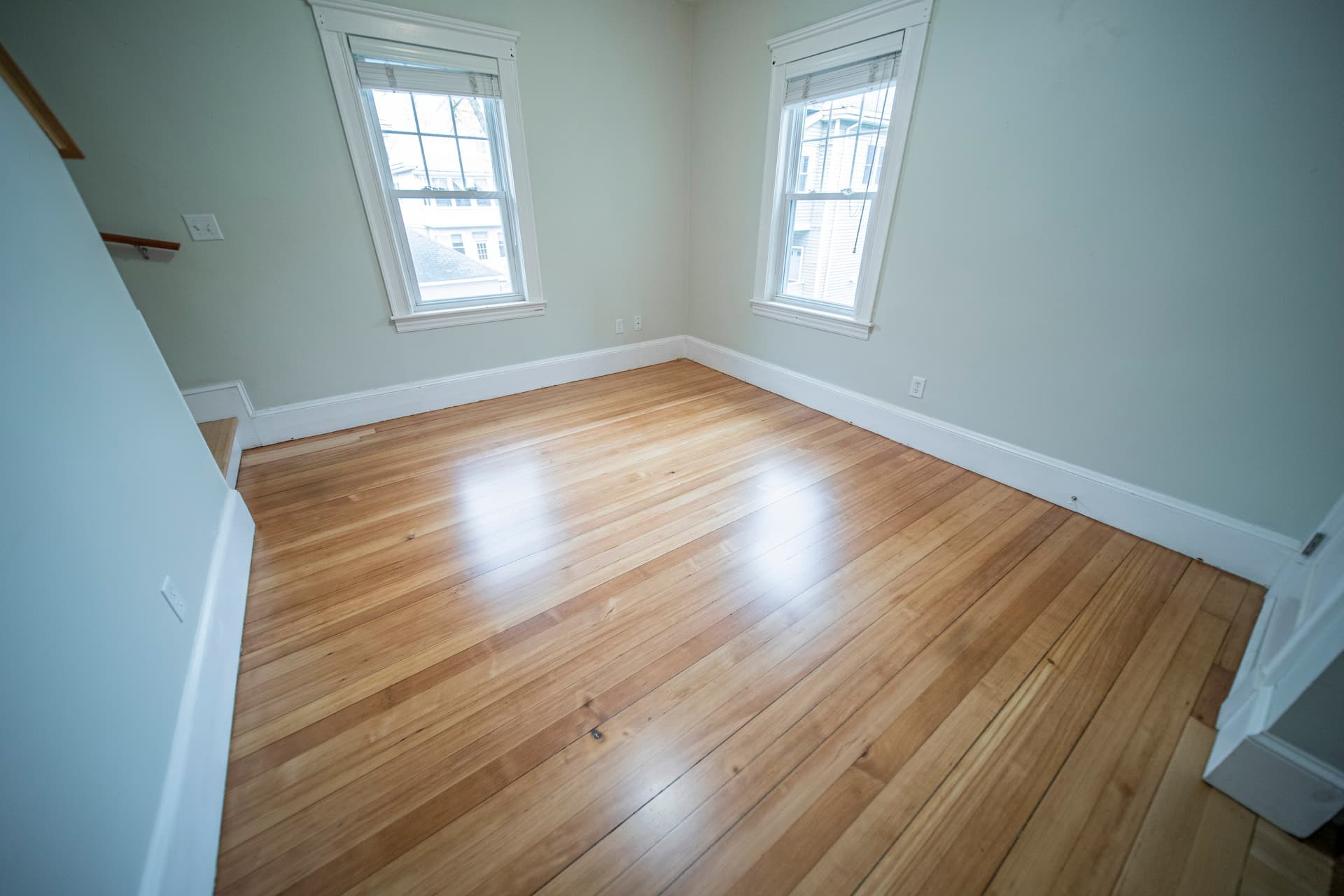Buffing is an important step in preserving the durability and appearance of your floors. It's a simple procedure, but the impact it makes may be dramatic. Our expertise in floor maintenance at Weles Wood Floor Services guarantees that this guide will give you practical and simple advice on how to keep your hardwood floors looking their best.
Understanding Hardwood Floors and When to Buff
Identifying the Right Time for Buffing
Hardwood floors, with their various finishes and ages, need a variety of cleaning methods. Knowing when your floor requires buffing is the key to good polishing. It's usually time to buff when:
-
The floor loses its luster and seems dreary.
-
Minor scratches appear, but the wood beneath is not visible.
-
The finish appears weathered but is not fully worn away.
Different Finishes, Different Approaches
Hardwood floor finishes require different types of upkeep. For example:
-
Polyurethane-finished floors typically require polishing every 3-5 years to keep their gloss.
-
Depending on foot activity, oil-based finishes may require more regular care.
Remember that buffing is used for maintenance, not repair. If your flooring has extensive scratches or structural damage, more than just polishing is required.
Tools and Materials Required
Essential Tools for Effective Buffing
The proper tools and materials are required to enable a smooth and efficient buffing procedure. Here's a concise list:
-
Buffing Machine: A must-have for an even and professional finish.
-
Sanding Screens: Different grits for various levels of buffing.
-
Buffing Pads: Attach to the machine for effective polishing.
-
Wood Floor Cleaner: For pre-buffing cleaning.
-
Floor Polish: To give your floor a fresh, new look.
Choosing the Right Products
It is critical to choose high-quality items. Choose a floor polish that matches the finish of your hardwood floors, whether it's water-based, oil-based, or wax-based. The polish's compatibility with the finish of your floor is critical for achieving the best results.
Room and Floor Preparation
Setting the Stage for Buffing
Preparation is key to a successful buffing process. Here's how to get your room and floor ready:
-
Clear the Area: Remove furniture, rugs, and any movable items from the room.
-
Clean the Floor: Sweep or vacuum thoroughly to remove dust and debris.
-
Mop with Care: Use a damp (not wet) mop with a suitable cleaner to avoid damaging the wood.
-
Check for Repairs: Inspect for any nails or screws sticking out and hammer them down. Fill any significant cracks or gaps.
Creating the Right Environment
Make sure the room is well-ventilated. Open windows or use fans to circulate air and hasten drying after polishing. Maintain a regulated room temperature as well to avoid any negative impacts on the wood or finish.
The Buffing Process: A Detailed Guide
Step-by-Step Buffing Instructions
-
Attach the Right Grit Screen: Start with a coarser grit (around 60-80) for initial buffing and switch to a finer grit (around 100-120) for a smoother finish.
-
Begin Buffing: Move the machine along the grain of the wood. Start from one corner of the room, working your way across systematically to ensure even coverage.
-
Regularly Check the Screen: The screen can clog with dust and old finish. Change it when it's no longer effective.
-
Buff the Edges: Use a hand-held orbital sander or a buffer with a smaller pad for the room's edges and corners.
-
Clean Up: After buffing, thoroughly clean the floor to remove all dust and debris. This might require sweeping, vacuuming, and a damp mop.
Pro Tips for a Perfect Finish
-
Always keep the buffer moving to avoid sanding down too deeply in one spot.
-
Overlap your passes slightly to ensure no area is missed.
-
Remember, buffing is more about finesse than force.
Safety Measures
Prioritizing Safety During Buffing
Because buffing hardwood floors requires both machinery and manual work, safety is a key priority. The following are critical safety precautions:
-
Protective Gear: Wear safety goggles, a dust mask, and ear protection. This shields you from dust particles, noise, and any flying debris.
-
Proper Ventilation: Ensure the room is well-ventilated to avoid inhaling dust and fumes. Open windows and use fans as necessary.
-
Handling Equipment with Care: Familiarize yourself with the buffing machine's operation. Always turn it off when changing pads or screens.
-
Keeping the Area Clear: Ensure the room is free of obstacles that could cause tripping or interference with the buffing process.
-
Electrical Safety: Check the cords for any damage and make sure they are not in the path of the buffing machine to prevent tripping or electrical hazards.
First Aid and Emergency Preparations
Have a first aid kit accessible and know the basic procedures for cuts or abrasions. In case of any significant injury, stop the work and seek medical attention immediately.
Post-Buffing Care
Maintaining Your Floors After Buffing
After-buffing maintenance is critical for preserving the longevity and appearance of your hardwood floors. Here are some important post-buffing care tips:
-
Applying Floor Finish: After buffing, apply a suitable floor finish. This protects the wood and gives it a fresh, new look. Follow the manufacturer's instructions for the best results.
-
Waiting Time: Allow adequate time for the finish to dry. Avoid walking on the floor during this period. The drying time can vary based on the type of finish and environmental conditions.
-
Regular Cleaning: Maintain a regular cleaning routine. Use a soft broom or a vacuum with a hardwood floor attachment to remove dust and debris. Avoid using wet mops or harsh chemicals that can damage the finish.
-
Preventive Measures: Place rugs or mats in high-traffic areas to reduce wear. Use furniture pads under legs to prevent scratches.
-
Periodic Maintenance: Regularly inspect the floor for signs of wear. A well-maintained floor may only need buffing every few years, depending on foot traffic and usage.
Long-term Care Strategy
Consider developing a maintenance plan. This might include daily sweeping, weekly vacuuming, and an annual examination to see whether extra buffing or more severe care is required.
DIY vs. Professional Buffing
Weighing Your Options
When it comes to buffing hardwood floors, you have two main choices: doing it yourself (DIY) or hiring professionals. Here’s a breakdown of both:
|
DIY Buffing |
Professional Buffing |
|
|
Pros |
Low cost, personal pleasure from finishing the assignment, and scheduling flexibility. |
Expertise and expertise that results in a high-quality finish, expediency in finishing the task, and no need for you to purchase or rent equipment. |
|
Cons |
Time and effort are required to learn and execute effectively, there is a danger of harming the floor if done wrong, and equipment must be rented or purchased. |
More expensive than DIY, and scheduling is dependent on the availability of the service provider. |
Making the Right Decision
Consider your skill level, the state of your flooring, and your budget. Professional services may be a better choice if your floors have significant concerns or you are confused about the procedure. DIY might be a realistic choice for routine maintenance if you're familiar with the technique.
Choosing Weles for Professional Buffing
Consider Weles, your dependable hardwood flooring provider, when it comes to expert polishing. Our crew combines years of professional knowledge to ensure that your floors are properly cared for. We employ cutting-edge equipment and processes that are suited to the unique demands of your hardwood floors. Choosing Weles means choosing peace of mind, knowing that your floors are in the hands of professionals who are committed to attaining the greatest levels of beauty and durability.
Avoiding Common Mistakes
Steering Clear of Buffing Blunders
Whether you're doing your hardwood floor buffing or assessing professional work, being aware of common blunders will help you get a better result. Here are some common mistakes to avoid:
-
Skipping Prep Work: Neglecting thorough cleaning and room preparation can lead to subpar results. Ensure the floor is free of debris and furniture before starting.
-
Incorrect Grit Usage: Using too coarse a grit can damage the floor, while too fine a grit might not be effective. Match the grit to your floor’s condition.
-
Over-Buffing: Excessive buffing can wear down the finish or the wood itself. It’s important to buff just enough to rejuvenate the floor without causing damage.
-
Uneven Buffing: Moving too quickly or irregularly can result in uneven finishes. Maintain a steady pace and ensure even coverage across the floor.
-
Ignoring Safety Measures: Overlooking safety gear and precautions can lead to accidents. Always prioritize safety, especially when operating machinery.
Conclusion
Embracing the Beauty of Well-Maintained Floors
Maintaining and caring for your hardwood floors is a continuous commitment to preserve your home's beauty and individuality. Buffing is an important part of your trip since it allows you to renew your floors and keep them looking their best.
Key Takeaways:
-
Regular Maintenance: Maintaining your flooring regularly is critical to its lifespan.
-
Proper Techniques: Effective buffing requires the use of the proper tools, procedures, and safety considerations.
-
Professional Expertise: The talents and expertise of experts such as Weles may sometimes make all the difference.
Choose Weles for Reliable Expertise.
We appreciate the value and significance of your hardwood floors at Weles. Every job we do demonstrates our dedication to excellence in floor maintenance. We're here to help you preserve the beauty and integrity of your hardwood floors, whether you want to buff them yourself or entrust them to our trained crew.



